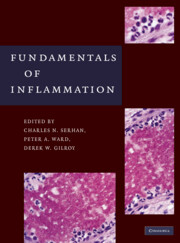Book contents
- Frontmatter
- Contents
- Contributors
- Preface
- PART I THE INFLAMMATORY RESPONSE – AN OVERVIEW
- PART II INDIVIDUAL CELL TYPES
- 4A Neutrophils I
- 4B Neutrophils II
- 5 Mast Cells as Sentinels of Inflammation
- 6 Basophils
- 7 Eosinophils
- 8 Macrophages
- 9 Lymphocytes
- 10 Fibroblasts and Stromal Cells
- 11 Neutrophil–Endothelial Cell Interactions
- PART III CHEMICAL MEDIATORS
- PART IV IMMUNOPHARMACOLOGY
- PART V INFLAMMATORY DISEASES/HISTOLOGY
- PART VI ANIMAL MODELS OF INFLAMMATION
- Index
- References
4B - Neutrophils II
from PART II - INDIVIDUAL CELL TYPES
Published online by Cambridge University Press: 05 April 2014
- Frontmatter
- Contents
- Contributors
- Preface
- PART I THE INFLAMMATORY RESPONSE – AN OVERVIEW
- PART II INDIVIDUAL CELL TYPES
- 4A Neutrophils I
- 4B Neutrophils II
- 5 Mast Cells as Sentinels of Inflammation
- 6 Basophils
- 7 Eosinophils
- 8 Macrophages
- 9 Lymphocytes
- 10 Fibroblasts and Stromal Cells
- 11 Neutrophil–Endothelial Cell Interactions
- PART III CHEMICAL MEDIATORS
- PART IV IMMUNOPHARMACOLOGY
- PART V INFLAMMATORY DISEASES/HISTOLOGY
- PART VI ANIMAL MODELS OF INFLAMMATION
- Index
- References
Summary
INTRODUCTION
Polymorphonuclear neutrophil leukocytes (PMN) are “professional” phagocytic cells of the innate immune system that act as the first line of defense against invading pathogens, principally bacteria and fungi but also viruses. Because of their powerful micro bicidal equipment, they have a major role in inflammatory responses other than anti-infectious defenses. In fact, after agonist challenge, neutrophils have the capacity to generate reactive oxygen species (ROS) and release lytic enzymes with potent antimicrobial activity, which are all essential for pathogen killing. Conversely, PMN-derived ROS and proteases may also damage the surrounding tissues if released in an uncontrolled manner, as observed in inflammatory diseases dominated by neutrophils. Nevertheless, it is now clear that the role of neutrophils goes far beyond phagocytosis and pathogen killing, as uncovered in the past two decades (Figure 4B.1). For instance, it has been documented that neutrophils have the capacity to migrate toward the lymph nodes and to express major histocompatibility complex class II (MHC II) molecules, once appropriately activated. An additional and fascinating aspect that has gradually come to light is the ability of neutrophils to newly express a number of genes, whose products lie at the core of inflammatory and immune responses. Not only neutrophils synthesize numerous proteins involved in their effector functions, including some complement components and Fc receptors, but they also produce a variety of cytokines and chemokines.
- Type
- Chapter
- Information
- Fundamentals of Inflammation , pp. 49 - 64Publisher: Cambridge University PressPrint publication year: 2010
References
- 1
- Cited by



